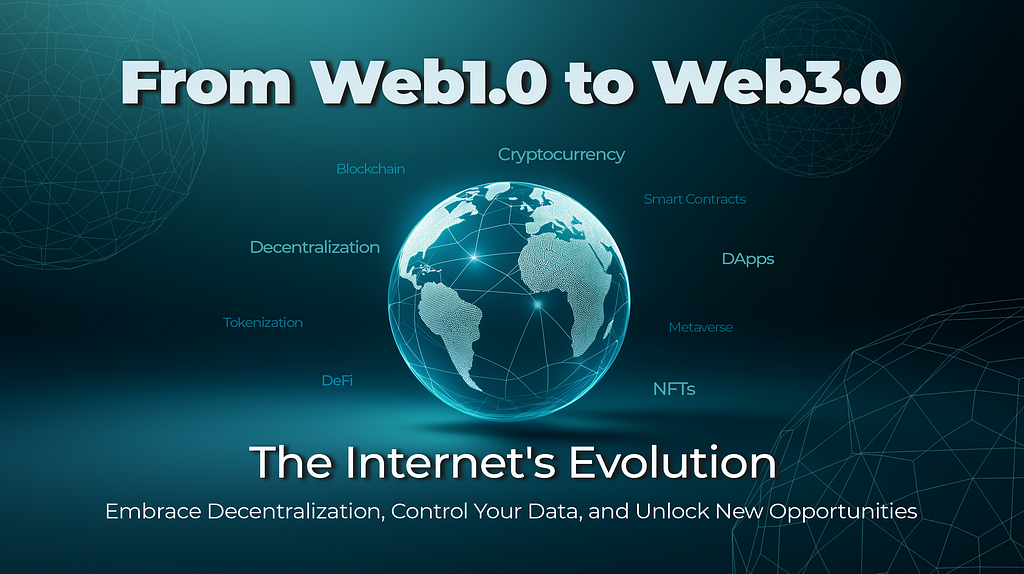
The Journey Begins: What Was Web1.0? 📜
In the early days of the internet, Web1.0 was born. This was the era of static websites — think of it as the “read-only” web. Websites were simple, offering limited interaction. Content was created by a few and consumed by many. If you remember browsing through basic HTML pages with plain text and images, you’ve experienced Web1.0. It was a world where users were mostly passive viewers, and content was centralized, controlled by the few who had the resources to create and host websites.
The Rise of Web2.0: Interactivity and User-Generated Content 🌐
Then came Web2.0, the internet we are most familiar with today. This phase marked a significant shift, often referred to as the “read-write” web. The key feature of Web2.0 was the rise of social media platforms, blogs, and interactive websites. This was when the internet became a place for participation. Users not only consumed content but also created it. Platforms like Facebook, YouTube, and Twitter allow anyone to publish content, share opinions, and connect with others across the globe.
However, this evolution came with a cost — centralization. Large tech companies began to control vast amounts of data, leading to concerns over privacy, security, and the ownership of content. While Web2.0 democratized content creation, it also centralized power, putting it in the hands of a few large corporations.
Enter Web3.0: The Decentralized Internet 🌍
Now, we stand on the brink of another revolution — Web3.0. This new phase of the internet is often described as the “read-write-own” web. Web3.0 aims to address the shortcomings of Web2.0 by decentralizing control and giving power back to the users. But what exactly does this mean?
Key Features of Web3.0 🔑
- Decentralization: Unlike Web2.0, where data is stored in centralized servers, Web3.0 operates on blockchain technology. This means data is distributed across a network of nodes, reducing the risk of a single point of failure and making the internet more resilient and secure.
- Ownership: In Web3.0, users own their data. Through technologies like cryptographic keys and non-fungible tokens (NFTs), individuals can have full control over their digital identities, assets, and content. This ownership is backed by the security of blockchain, making it nearly impossible to tamper with or steal.
- Interoperability: Web3.0 is designed to be interoperable, meaning different platforms and services can seamlessly interact with each other. This is a stark contrast to the walled gardens of Web2.0, where platforms often operate in isolation.
- Smart Contracts: Another key innovation in Web3.0 is the use of smart contracts — self-executing contracts with the terms directly written into code. These contracts enable trustless transactions, reducing the need for intermediaries and ensuring that agreements are automatically enforced.
- Tokenization: Web3.0 introduces the concept of tokenization, where digital assets can represent ownership of real-world assets, shares in a project, or even a stake in a decentralized application (dApp). This not only democratizes access to investment opportunities but also aligns incentives between creators and users.
Why Should You Care About Web3.0? 🤔
Web3.0 is not just a technological shift; it’s a philosophical one. It represents a move towards a more open, transparent, and user-centric internet. As more aspects of our lives move online, from finance to social interactions, the principles of Web3.0 become increasingly important.
- Control Your Data: In Web3.0, you control your data and who has access to it. This is a significant shift from the current model, where your data is often collected, stored, and monetized by corporations.
- Earn While You Participate: Through decentralized finance (DeFi) platforms and tokenized ecosystems, Web3.0 allows users to earn rewards for their participation. This could be through staking tokens, participating in governance, or contributing to a decentralized application.
- A New Wave of Innovation: Web3.0 is still in its early stages, but the potential for innovation is immense. New business models, applications, and services will emerge, offering opportunities for those who are willing to explore and participate in this new digital economy.
The Road Ahead: Challenges and Opportunities 🚧
While the promise of Web3.0 is exciting, it’s important to acknowledge the challenges that lie ahead. The technology is still evolving, and widespread adoption will take time. Issues such as scalability, energy consumption, and regulatory hurdles need to be addressed. However, the potential rewards are significant, and those who engage with Web3.0 early stand to benefit the most.
Conclusion: Embracing the Future 🌟
Web3.0 is more than just the next version of the internet; it’s a fundamental shift in how we interact with digital systems. It brings with it the promise of a more equitable and user-controlled internet, where individuals have the power to own their data, assets, and online identities. As we move forward, understanding and embracing Web3.0 will be crucial for navigating the digital landscape of the future.
Launch App | Telegram News | X (Twitter)
From Web1.0 to Web3.0: The Evolution of the Internet and What It Means for You 🚀 was originally published in The Dark Side on Medium, where people are continuing the conversation by highlighting and responding to this story.
from The Dark Side - Medium https://ift.tt/bxsrwEL
0 Comments